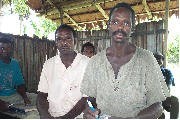Kayagar in Indonesia

Photo Source:
GMI Papua
|
Send Joshua Project a map of this people group.
|
| People Name: | Kayagar |
| Country: | Indonesia |
| 10/40 Window: | Yes |
| Population: | 15,000 |
| World Population: | 15,000 |
| Primary Language: | Kayagar |
| Primary Religion: | Ethnic Religions |
| Christian Adherents: | 20.00 % |
| Evangelicals: | 3.00 % |
| Scripture: | Translation Started |
| Ministry Resources: | No |
| Jesus Film: | No |
| Audio Recordings: | No |
| People Cluster: | New Guinea |
| Affinity Bloc: | Pacific Islanders |
| Progress Level: |
|
Introduction / History
The Kayagar are sometimes known as the Wiyagar, Kaygir, Kajagar, Kaygi people. Tamario and Wiyagar are some of this language's dialects. Both Indonesian and Kayagar are used in the church services.
What Are Their Lives Like?
They live by garden and plant fruit trees hunters/gathers in the swampy. With their land at an altitude of less than 100 meters above sea level the Kayagar people can best be accessed by boat.
There is 1 junior high school in the language area. There has been some attempt to translate songs and prayers into the Kayagar language.
The women primarily process sago, pleat grass mats, and net fish. The Kayagar people generally wear modern clothing but rarely wash the cloths. The people eat sago, sagoworm, fish and pig, vegetables or fruits. The Kayagar have bow/arrows, spears, nets, steel axes, and some have a gun, tableware and furniture. There is usually 1-2 boat motors/village. Houses are generally built on stilts with plank or sago walls and a zinc or leaf roof.
What Are Their Beliefs?
It is estimated that less than half of the Kayagar speakers have understood the gospel but there are some Protestant churches and quite a few Catholic churches in the language area.
What Are Their Needs?
There is very little infrastructure in the area: only some private generators, and an SSB radio w/o antenna in Arare. The people get their drinking water generally straight from the river or from rainwater. Malaria, lung diseases, yaws/ulcers and other skin diseases are common. There are only a few health workers and small clinics in the language area.
Prayer Points
Pray for a multiplying movement of disciples who will bring healing, unity, and lasting hope, transforming entire villages through the power of Christ.
Pray that soon they will become Christ's ambassadors to disciple less-reached nations.
Pray for the Lord to bless Kayagar Christian believers with an abundance of God's love, joy, and kindness, drawing others to the King of kings.
Pray for them to be grateful for God's spiritual and physical provisions.
Pray that the Holy Spirit will move powerfully, so that they may become a light to those who still lack a relationship with Jesus Christ.